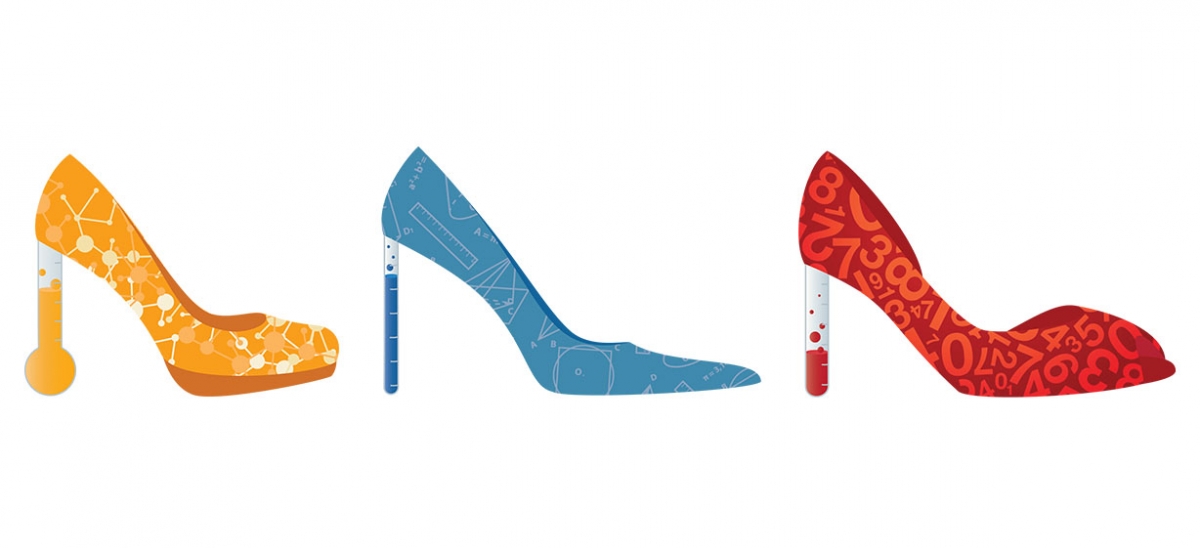
When Elizabeth Roeske was growing up in the small New Jersey town of Salem, she seemed a natural for a career in science. Several members of her family are scientists, and she was planning to study chemistry and environmental science in college. But she found little peer support—”No one from my high school was planning to major in chemistry”—and there seemed a chance she would suffer the same fate as the many young women who are discouraged, deflected and dissuaded from STEM studies.
But when she enrolled at Duquesne University, she was embraced by the Bayer Scholars Program, an initiative of Duquesne and Bayer Corporation that provides financial support and mentoring for students pursuing STEM careers. Just as significantly, she drew inspiration from the professional women in her environment.
“In Duquesne’s chemistry department, about 30 percent of faculty are women,” she says. “I never saw where women couldn’t make it because there were so many successful women there.”
Following her graduation this year, she joined Bayer as a technical trainee. Roeske’s story is a shining example of how the private and educational sectors can work together to motivate women in STEM studies; it’s also a reminder that, as a society, we don’t do it very well or very often.
“I knew I really liked science, but I had no idea what I could do with it,” Roeske says. “We should start familiarizing students with STEM fields at an early age.”
The STEM gap may be a real threat to continued American prosperity. According to the U.S. Bureau of Labor Statistics, in the decade ending in 2020, U.S. employers will create about 2.1 million jobs in STEM disciplines as well as the professional sector. But who will fill those jobs? According to STEMconnector, a clearinghouse for STEM information, the manufacturing sector already has 600,000 jobs it can’t fill because of the shortage of STEM skills, a gap that could become a chasm.
The regional situation mirrors the national scene. In a 2012 study by the Allegheny Conference on Community Development, companies in the region’s growing energy sector indicated they are “highly confident” in their ability to fill only one of every five job openings in key technical categories.
One of the most vexing aspects of the STEM gap is the chronic under-representation of women and minorities in STEM jobs. The Bureau of Labor Statistics indicates that women constitute 47 percent of the national workforce, but their percentages in STEM fields fall well below that. For example, women make up 34 percent of chemists and material scientists, but only 7 percent of electronics engineers and electrical engineers. They are 26 percent of environmental scientists and geoscientists but only 7 percent of mechanical engineers.
The representation of minorities is just as disappointing. Hispanics, blacks and American Indians/Alaska Natives constitute 9 percent of workers in science and engineering occupations, but 26 percent of all U.S. residents between the ages of 20 and 70.
The conventional wisdom preaches that girls just aren’t as interested in math and science, but figures from the National Girls Collaborative Project tell a different story. In their K-12 years, on a percentage basis, more girls than boys take algebra II and precalculus/analysis, while 17 percent of each gender takes calculus. So where are girls abandoning the STEM path?
Bayer has been researching that issue for 17 years, interviewing young women and minorities about career aspirations and obstacles. Rebecca L. Lucore, chief of staff for Bayer MaterialScience LLC (NAFTA region), says Bayer’s findings, informal though they be, point to one significant, consistent barrier.
“All of them said they found the most discouragement at the college and university level and from their college professors,” Lucore said. “We’ve spent millions investing at the elementary and secondary school levels at getting kids to pursue science, and then they’re getting discouraged when they get to college.”
If our education system is contributing to the under-representation of women and minorities in STEM fields, then many say it’s high time to address that–both by fixing the system and enhancing it with creative new programs. A number of local organizations are doing just that.
At the University of Pittsburgh, the Swanson School of Engineering has been targeting the issue since 1993 and knows full well the stakes.
“Engineers are our next-generation innovators, inventors and problem-solvers,” says Mary Besterfield-Sacre, associate professor of industrial engineering and director of Swanson’s Engineering Education Research Center. “We potentially are missing opportunities for solving problems because of the lack of diversity.”
Today, Swanson’s efforts are embodied in a pair of companion programs. Its pre-college initiative, called Investing Now, reaches out to female and minority students, bringing them to campus during the summer to meet Swanson faculty and participate in hands-on activities.
Once students enroll, Swanson’s EXCEL program provides the resources and support to keep them motivated. “We’re not just bringing students in,” says Sylvanus Wosu, Swanson’s associate dean for diversity. “We’re also finding ways to retain them. One of those ways is to make sure the culture is welcoming and inclusive.”
To that end, Swanson requires diversity education courses for all freshmen, and it has diversified its faculty as well. In some departments, as many as 50 percent of faculty are women. The school also counts on such student organizations as the National Society of Black Engineers to recruit and mentor new students.
“On our campus, we have a very strong Society of Women Engineers,” says Besterfield-Sacre. “When I was in school in the ’80s, I looked at them and said, ‘I don’t want anything to do with this.’ It was all about how to be a woman in a man’s world, dressing for success. Things have very much changed. The girls create an environment for themselves.”
Swanson’s results are impressive. In 2010-11, 38.6 percent of Swanson’s doctorate degrees in engineering were awarded to women, ranking the school No. 1 in the U.S. That same year, Swanson awarded 10.5 percent of its doctoral degrees in engineering to minorities, more than 72 percent better than the 2004 figure. The very next year, however, the percentages for both groups plummeted, demonstrating how difficult it is to maintain momentum.
“Imagine if many schools joined in this effort,” Wosu says. “We can make a difference. We can move the bar.”
But he also knows that whatever higher ed does is only one piece of the puzzle.
“We have a K-12 system that needs to be completely revamped. If it isn’t, no matter what the universities do, we still will be lagging behind. Teachers need continuing education on how to teach math and science.”
That’s where ASSET STEM Education comes in. Since 1994, the nonprofit ASSET has been teaching the teachers; that is, working with school districts and educators throughout the region to improve instruction in STEM fields. ASSET helps professional development in a number of ways, the most important of which may be providing teachers with classroom materials that inspire creativity and critical thinking.
But that’s not all it does. Participating districts often loan teachers to ASSET for two-year stints that immerse them in inquiry-based learning techniques, ideas they then carry back to their districts. The organization also undertakes case studies of teachers, who can record their own performances for later critique and also review their work with professional evaluators.
“We’re trying to change the ways educators teach and the ways students learn,” says Cynthia Pulkowski, ASSET’s executive director. “If teaching is inquiry-based and gives students opportunities to inquire and articulate, you’ll see it go cross-curricular. You’ll see it in reading and social studies. Once people make the shift, they’ll never stop teaching or learning that way. That’s true sustainability.”
ASSET’s reach goes beyond K-12 classrooms, as it works with colleges and universities as well as informal educators, such as the YMCA. It has a second Pennsylvania office in Malvern and is planning a third in Bloomsburg, though all classroom materials are housed at its South Side headquarters. ASSET’s work is so highly regarded that it’s been tapped for professional development by school districts in New Mexico, California and Texas. In Pennsylvania, ASSET reaches more than 4,000 teachers and 175,000 students.
The organization regularly evaluates the impact of its work, a component that’s often required under the federal grants it receives. The results, Pulkowski reports, are improved science scores on state tests.
“Students need to be fluent, not just literate,” she says. “They need to be able to articulate a complex idea, apply systems and models from one environment to another, learn how to deconstruct things, then construct things that are significant so they become intrinsic. The impact has been great on the literacy piece. The schools have a great foundation. Now, it’s important to move them to fluency. It’s a deeper dive now. We have the first layer. Now, let’s get the second one.”
Teachers are getting still further assistance from local leaders in informal education, such as the Carnegie Science Center and its Chevron Center for STEM Education and Career Development, which provides a rich variety of programs to introduce students to the possibilities of STEM careers. Linda Ortenzo, director of STEM programs for the center, believes the days when outside learning experiences could be regarded as something less than obligatory are over.
“We’ve gone from nice to necessary,” she says. “The informal aspect of STEM education provides a gateway to discoveries, innovations and career possibilities that just aren’t available in classrooms. It’s an integral part of students’ STEM education experiences.”
To make sure girls are getting the message, the center offers such programs as Girls Engaged in Math + Science (GEMS), on-site, after-school workshops for girls in grades 6-8 that feature female role models in STEM careers. GEMS locales include Pittsburgh and Wilkinsburg schools and such community partners as the Duquesne-West Mifflin Boys and Girls Club. Also offered is Click! Spy School, a summer camp program where girls aged 10-14 solve mysteries and complete covert missions using key STEM concepts, and CanTEEN, a resource to inspire girls to see themselves in STEM careers through gaming and other online activities.
The programs reflect what we’ve discovered about how and why girls learn, an element sometimes missing from more traditional approaches.
“Girls like to work in teams,” Ortenzo says. “They like to solve real-world problems. They want to have a real impact. The experiences we design for them allow them to do those very things while introducing them to women in a wide range of STEM fields. They’re attractive people who have families and lives that are really appealing, so the students can see themselves in a way that breaks down the walls.”
In the next issue: Some observers insist that tearing down America’s education system and starting from scratch is the only way to bridge the STEM gap. Pittsburgh organizations aren’t going that far, but they’re introducing innovations that we’ll explore in our series conclusion.




